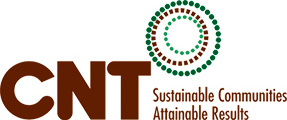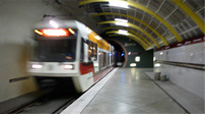Transportation & Community Development
A diverse, walkable community depends on a transportation infrastructure that provides a variety of ways to get around, serving pedestrians and transit-riders as well as drivers. Quality of life is key to the success of any urban community. A good transportation network also relies on healthy communities. This can be affected by housing sites, affordable and convenient transportation, easy access to shopping and services, safety and equity.
CNT promotes research and action on understanding housing and transportation affordability, revitalizing and developing communities and public involvement in shaping policy. CNT has worked on a number of projects designed to encourage community development and promote transportation options.
Why is this important?
- Housing plus transportation costs give a more complete assessment of affordability than housing costs alone.
- Transportation costs are driven more by neighborhood characteristics than by the number of people in a household or their income.
- Places with access to services, walkable destinations, extensive and frequent transit, access to jobs, and density have lower household transportation costs.
- Creating neighborhoods with housing and transportation affordability requires multiple and targeted strategies and coordination within and across government agencies and the private sector.
- Underutilized transit station areas present an opportunity to create additional affordable and diverse neighborhoods.
To learn more about CNT’s work in Transportation and Community Development, take a look at our projects, tools and resources on this page.
Monday, June 10th, 2013 at 3:03 pm

Flickr photo by alforque
There is a growing consensus that public spending cuts don’t just threaten the provision of crucial services but risk damaging our fragile economic recovery. Cuts to transportation funding are particularly harmful and are, as a recent survey conducted by the American Public Transit Association shows, especially unpopular. Seventy-four percent of respondents supported using public money to “create, expand and improve public transportation.” Nearly 90 percent agreed that public transportation improves access to jobs and close to 80 percent agreed that it “can help pave the way to a stronger economy.” Voters in metro areas across the country have voted to create dedicated revenue streams for transit funding (see Los Angeles and Denver examples).
As former Pennsylvania Governor Ed Rendell suggested, although political leaders have been reluctant to support increased taxes to pay for transit improvement, there is a growing realization that public transportation is as popular as it is essential. Expanding transit doesn’t just benefit train and bus passengers; it benefits motorists by helping to mitigate traffic congestion. It improves air quality and reduces dependence on foreign oil. Public money invested in transit ultimately comes back to the government in the form of higher tax revenues due to greater economic growth and lower unemployment. Advocates for public transportation still have a fight on their hands to convince opponents of the merits of investing in rail and bus services instead of highway expansion and to translate increasing public support into political action. Thankfully, as Governor Rendell says, “the tide is turning.”
Comments (0) »
Tuesday, June 4th, 2013 at 2:05 pm
 The promise of cargo-oriented development (COD) in Chicago’s South Suburbs got a boost from the Illinois General Assembly last week. Lawmakers passed a bill that would fund incentives to remediate and reuse brownfields to create intermodal, warehousing and light manufacturing jobs on over 1,500 industrial acres in a designated zone of freight-rich southern Cook County.
The promise of cargo-oriented development (COD) in Chicago’s South Suburbs got a boost from the Illinois General Assembly last week. Lawmakers passed a bill that would fund incentives to remediate and reuse brownfields to create intermodal, warehousing and light manufacturing jobs on over 1,500 industrial acres in a designated zone of freight-rich southern Cook County.
The South Suburban Brownfield Redevelopment Zone leverages unique south-suburban assets, such as the existing intermodal freight terminals owned by the Canadian National and Union Pacific railroads and their excellent access to rail and interstate highway networks.
“This is very good news for our efforts to achieve COD in the south suburbs,” said Kathryn Tholin, CEO of CNT. “Yet another opportunity now exists to attract infill investments from a growth industry that would otherwise go to remote locations or chew up more farmland. Further, by tackling the toughest obstacles to redevelopment—the acquisition and assembly of parcels—this bill will help communities clean up brownfields and make critical updates to aging public infrastructure.”
CNT collaborated with Representative William Davis (D-Hazel Crest), who sponsored the original House version of the bill, as well as the South Suburban Mayors and Managers Association (SSMMA) and Cook County to research, draft, and promote the bill. The bill’s passage represents a milestone in CNT’s eight-year effort to work with our south suburban partners in highlighting recognition of the region’s assets and leveraging them for sustainable redevelopment.
CNT’s previous work in Chicago’s South Suburbs includes promotion of a multi-jurisdictional strategy known as the Chicago Southland Green TIME (Transit, Intermodal, Manufacturing, Environment) Zone, the first initiative of its kind in the US. Additionally, CNT reports and publications, such as Making Smart Choices: Transit-Oriented Development Selector Analysis of South Suburban Corridors and Chicago’s South Suburbs: Smart Growth in Older Communities, helped to lay the groundwork for the brownfield bill and similar development strategies in the Chicago region.
The bill now goes to Governor Quinn’s desk for signature into law.
Comments (0) »
Monday, June 3rd, 2013 at 1:05 pm

When communities grow compactly, close to jobs and along transit routes, households have greater choice between affordable communities in which to live, increased employment opportunities close to home, and multiple transportation options connecting the two. However, several decades of fragmented regional planning in the Chicago region de-emphasized this connection between housing, transportation choice, and economic development in favor of increased highway capacity and continued suburban expansion. Cheap oil reinforced the illusion of growth for decades, but surging energy prices raised transportation costs and exposed household pocketbooks and municipal budgets to the true cost of sprawl.
To address this challenge, CNT proposed, in Prospering in Place, that the Chicago Metropolitan Agency for Planning (CMAP) establish Priority Development Areas (PDAs) that align investments in transportation, housing, and economic development across public agencies in regional activity centers.
Based on models innovated in the San Francisco Bay Area and Atlanta region, this framework empowers communities to volunteer PDAs within their town boundaries and access implementation dollars to realize their plans. PDAs can be communities that either meet a benchmark of housing, jobs, or transit service right now, or have planning in place for future growth and need the resources to get there.

Priority Development Areas will help communities like Blue Island, IL, secure the investments they need to implement sustainable planning in transit-oriented and cargo-oriented development.
After CNT gave 26 presentations to elected officials, state agencies, and stakeholder working groups on this topic, CMAP announced on May 8 that it will research and implement a PDA framework as regional policy. CMAP and CNT will partner over the remainder of the year to build partnerships at other agencies, particularly the Illinois Department of Transportation, Illinois Housing Development Authority, and the Department of Commerce and Economic Opportunity, to target additional housing, transportation, and economic development programs to the PDAs that CMAP designates. Although this is only the first step towards more sustainable development patterns, it signals a growing regional commitment to compact growth.
Comments (2) »
Read more Transportation & Community Development news »












